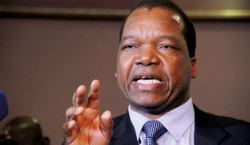

A drop in petrol prices last month helped to drive US inflation to the lowest rate since July.
Prices increased at a rate of 3.2% over the 12 months to October, the Labor Department said.
That was down from 3.7% a month earlier.
Housing costs continued to climb, but overall price pressures were milder than analysts had expected, suggesting the country’s fight against inflation may nearly be over.
From September to October, the price index – which measures prices of a basket of items – was unchanged. Stripping out food and energy prices, which tend to fluctuate and mask wider trends, prices rose by 0.2%, easing from a month earlier.
Stocks surged following the report, as investors bet the US central bank will not have to do more to cool the economy to slow inflation.
The Federal Reserve has already raised interest rates sharply since last year, aiming to stabilise prices that were soaring at the fastest pace in decades.
Analysts said the relatively mild price increases make the US central bank less likely to raise borrowing costs again.
“The continued moderation of inflation will help keep the Federal Reserve on the sidelines,” said Greg McBride, chief financial analyst at Bankrate.com.
Prices for petrol have fallen more than 5% since last year, and tumbled from September to October, according to the Labor Department. The price of new and used cars and trucks also dropped.
But Mr McBride said that trouble spots remain, pointing especially to housing costs, which have climbed 6.7% over the last 12 months.
Housing costs accounted for more than 70% of inflation last month, according to the Labor Department.
“The slower pace of inflation is little comfort to households still dealing with the cumulative effect of rising prices,” he said. “The strain on household budgets is real with the consumer price index up more than 18% in the past three years.”
Unlike in the UK, housing costs are heavily weighted in calculations of US inflation. The price index tracks a range of items, including rents, hotel rates and household insurance.
Home sale prices are not included. But the index also factors in a hypothetical figure called “owners’ equivalent rent”, meant to measure what homeowners would have to pay to rent a similar place.
Analysts have been predicting for months that shelter costs would start to ease, noting that the official inflation data, which measures what households pay, lags the market because leases tend to lock in rates.
Private sector measures, which focus on new leases, have shown rent increases stabilise, or rents even fall, as a burst of new apartments started off the back of a huge leap in rents during the pandemic became available.
Analysts said it has taken longer than expected for the change in the market to show up in the price index. But they see signs that it is happening now, noting that the increase in shelter costs on an annual basis has slowed considerably since April.
“Things are headed in the right direction,” said Orphe Divounguy, senior economist at Zillow, adding that he expected rents to increase at the 3-5% annual pace that was typical before the pandemic. “The rental market has somewhat normalised.”
More recently however, construction has cooled because of higher borrowing costs.
Sarah House, economist at Wells Fargo, said she also expected increases in housing costs to slow in coming months, but she warned: “The steady rate of primary rent inflation cautions that the slowdown might not be as sharp as private sector measures have implied.” — bbc.com